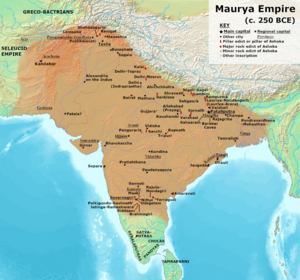Maurya Empire

The Maurya Empire, or the Mauryan Empire, was a geographically extensive historical power in the Indian Subcontinent based in Magadha. It was founded by Chandragupta Maurya in 322 BCE, and existed in loose-knit fashion until approximately 185 BCE.[4]
The empire reached its greatest extent during the reign of Ashoka the Great (ca. 268–232 BCE). During Ashoka's rule, the empire briefly controlled the major urban hubs and arteries of the Indian subcontinent excepting the deep south.[4] It declined for about 50 years after Ashoka's rule, and dissolved in 185 BCE with the assassination of Brihadratha by Pushyamitra Shunga and foundation of the Shunga Empire in Magadha.
Under the Mauryas, internal and external trade, agriculture, and economic activities thrived and expanded across South Asia due to the creation of a single and efficient system of finance, administration, and security. After the Kalinga War, the Empire experienced nearly half a century of centralized rule under Ashoka. Ashoka's embrace of Buddhism and sponsorship of Buddhist missionaries allowed for the expansion of that faith into Sri Lanka, northwest India, and Central Asia.[5]
The Arthashastra[6] and the Edicts of Ashoka are the primary sources of written records of Mauryan times. The Lion Capital of Ashoka (a sculpture of four lions back to back) at Sarnath is the national emblem of the Republic of India.
Notes
- ↑ Smith, Vincent Arthur (1920), The Oxford History of India: From the Earliest Times to the End of 1911, Clarendon Press, pp. 104–106
- ↑ Majumdar, R. C.; Raychaudhuri, H. C.; Datta, Kalikinkar (1950), An Advanced History of India (Second ed.), Macmillan & Company, p. 104
- ↑ Schwartzberg, Joseph E. A Historical Atlas of South Asia, 2nd ed. (University of Minnesota, 1992), Plate III.B.4b (p.18) and Plate XIV.1a-c (p.145)
- ↑ 4.0 4.1 Dyson, Tim (2018), A Population History of India: From the First Modern People to the Present Day, Oxford University Press, pp. 16–17, ISBN 978-0-19-882905-8 Quote: "Magadha power came to extend over the main cities and communication routes of the Ganges basin. Then, under Chandragupta Maurya (c.321–297 bce), and subsequently Ashoka his grandson, Pataliputra became the centre of the loose-knit Mauryan 'Empire' which during Ashoka's reign (c.268–232 bce) briefly had a presence throughout the main urban centres and arteries of the subcontinent, except for the extreme south."
- ↑ Hermann Kulke 2004, p. 67.
- ↑ "It is doubtful if, in its present shape, [the Arthashastra] is as old as the time of the first Maurya", as it probably contains layers of text ranging from Maurya times till as late as the 2nd century CE. Nonetheless, "though a comparatively late work, it may be used ... to confirm and supplement the information gleaned from earlier sources". (Raychaudhuri & Mukherjee 1996, pp. 246–247)
| This article includes content from Maurya Empire on Wikipedia (view authors). License under CC BY-SA 3.0. |